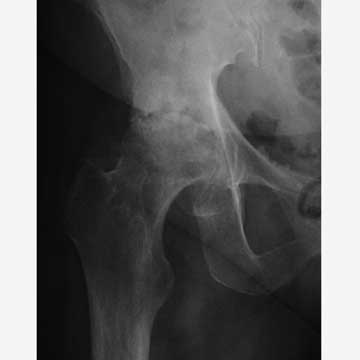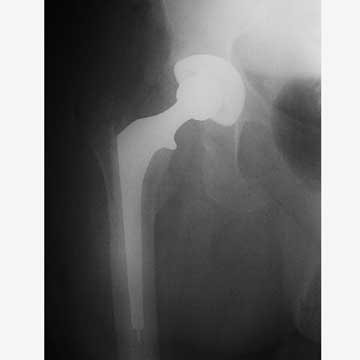|




|
Total Hip Arthroplasty, THA, THR, total hip replacement
THA CPT
THA Applicable ICD-10 Codes
- M16.0 - Bilateral primary osteoarthritis of hip
- M16.1 - Unilateral primary osteoarthritis of hip
- M16.10 - Unilateral primary osteoarthritis, unspecified hip
- M16.11 - Unilateral primary osteoarthritis, right hip
- M16.12 - Unilateral primary osteoarthritis, left hip
- Z47.1 - Aftercare following joint replacement surgery
- Z47.32 - Aftercare following explantation of hip joint prosthesis
- Z96.641 - Presence of right artificial hip joint
- Z96.642 - Presence of left artificial hip joint
- Z96.643 - Presence of artificial hip joint, bilateral
- Z96.649 - Presence of unspecified artificial hip joint
THA Indications
- persistent pain c limited ambulation, night pain, severe quality of life limitations despite conservative therapy, fractures, tumors
THA Contraindications
- age>80, non-ambulator, skeletally immature, active infection, neurotrophic joint, abductor mass loss, progressive neurologic disease.
- Young age (relative) >50% 15 year failure rate for pts <45yrs old(Mittlemeier, CORR 282)
- independent predictors for periprosthetic joint infection: higher American Society of Anesthesiologists score, morbid obesity, bilateral arthroplasty, knee arthroplasty, allogenic transfusion, postoperative atrial fibrillation, myocardial infarction, urinary tract infection, and longer hospitalization. (Pulido L, CORR 2008;466:1710)
THA Alternatives
- Non-op Treatment
- Arthrodesis--indications include arthritis, failed osteotomies, failed cup arthroplasty, young active patient. preoperative immobilization (hip spicca) to aquaint pt. fusion in 30 flexion, neutral adduction,rotation. fixation c Barr bolts or AO Cobra plate. Complications non-union, malposition, DJD, instability of ipsilateral knee/back, contralateral hip. Contraindicated for assocoated spinal pathology, ipsilateral knee pathology, bilateral hip pathology, AVN, women due worse with arthrodesis due to difficulty squating, sex. Favored postion = 20-30 degress hip flexion, neutral abd/adduction, neatraul int/external rotation. Good long-term pain relief and funtion. Many develop back and ipsilateral knee pain in long-term.
- Femoral osteotomy- restricted to localized defect. best in young non-obese pt. for head to be in abduction, a varus or adduction osteotomy is performed. vice verse for adduction.
- Hemiarthroplasty-requires normal acetabulum, not used for arthritis.
- conservative therapy-decreased activity, weight loss, nsaids, cane/walker.
- Arthroscopy; indicated for symptomatic labral tears, loose bodies, synovial chondromatosis. difficult
- Resection arthroplasty- results in limb shortening, need for externally supported ambulation,. Used for infection, unreconstructable hip arthroplasty
- Hip Resurfacing: Pseudotumor formation occurred in 28% of hips after an average follow-up of forty-one months. 72.5% were asymptomatic. Larger pseudotumors were associated with more complaints. Survival analysis showed an implant survival of 87.5% at five years. Failure occurred in 5.6% (eight) of 143 hips because of a symptomatic pseudotumor (Bisschip R, JBJS-A Am, 2013 Sep 04;95(17):1554-1560).
Total Hip Arthroplasty Approach Neurovascular Risks
- Anterolateral (Watson-Jones) approach risks the femoral nerve which is the most lateral structure in the anterior neurovascular bundle. The femoral artery and vein lie medial to the nerve. Retractors placed in the anterior acetabular lip may cause neurapraxia of the femoral nerve (quadriceps weakness) if retraction is prolonged or forceful. The femoral artery and nerve are protected by the interposed psoas muscle.
- Anterior (Smith-Petersen) approach risks the lateral femoral cutaneous nerve, causing numbness over the anterolateral thigh.
- Direct lateral (Hardinge) approach risk the superior gluteal injury and accompanying abductor insufficiency may occur during excessive splitting of the glutei.
- Posterior approach risks injury to the sciatic nerve which leads to foot drop.
THA Pre-op Planning / Special Considerations
- medical/dental evaluation, CBC, PT/PTT, Chem 7, templating joint, antibiotics, plan anticoagulation
- arrange DME (elevated camode, walker, bedside camode)
- Spinal anesthesia: general anesthesia has been associated with increased adverse events and mildly increased operating room times. (Basques BA, JBJS 2015:97:455-61)
- Cement-static interlocking, if microfractures occur there is no remodeling potential
- Cement techniques=porosity reduction(vacuum), pressurization cement, precoat stem, stem centralizer, cement gun, canal preparation, cement restrictor, collar on stem.M inimum of 2mm cement thickness desired between bone and stem. Avoid cement mantle defects(stem touches bone)
- Consider cementing for patients older than 80 years of age especially for Dorr type C bone. Osteoporosis is a risk factor for early failure of cementless femoral components.
- Cemented femoral components should be polished with smooth edges and tapered bodies. Collars have not been demonstrated to be superior.
- Femoral pressurization risks hypotension. Consider increased FiO2 and IV fluid rate during cementing. Phenylephrine should be available.
- Pressfit-dynamic biologic fixation, potential for remodeling. Porous coated =ingrowth fixation. Grit-blasted = ongrowth fixation. Rule of 50's =micromotion<50microns, porosity=40-50%, pores 50-150 microns, gaps<50microns
- Bearing Materials: metal on metal, Alumina/Zirconia Ceramic, Polyethylene.
- Hydroyapatite(HA) is osteoconductive
- Acetabular Screw: Anterosuperior quadrant acetabular screws risk external iliac artery and vein, anteroinferior screws risk the obturator nerve, artery, and vein. Acetab division are drawn by placing a line starting at ASIS and passing through acetab center and then a line perpendicular to that. Wasielewski RC, et al: Acetabular anatomy and the transacetabular fixation screws in total hip arthroplasty JBJS 1990;72A:501-508.
- Stability= 1-component design(head-neck ratio is primary determinant of arc range, excursion is 1/2diameter of fem head), 2-component alignment, 3-soft-tissue tension(abductors ie neck offset and length), 4-soft-tissue function
- Head size: small head(22mm)=high linear ware, low volumetric wear, low stability. Large head size(32mm)=low linear ware, high volumetric wear, higher stability. Poly debrie is related to amount of volumetric wear.
- Cup angle of 45 degrees with 15 degrees of stem and cup anterversion appears to maximize motion. (Barrack JAAOS 11:89, 2003)
- Femoral component placed in slight valgus c neck in 5-10 of anteversion.
- Acetabulum placed in 10-15 of anteversion & 45 of vertical orientation.
- Maximizing head-to-neck ratio with a trapezoidal rather than circular neck notably improves motion. (Barrack JAAOS 11:89, 2003)
- Neck offset, neck length
- Intra-operative Calcar fractures: remove stem, determine distal extent of the fracture. Generally can fix the calcar fracture with cerclage wires/cables then insert same stem.
Anterolateal -- Watson-Jones Approach
- Uses intermuscular plane between TFL and gluteus medius
- Involves partial or complete detachment of the abductor mechanism to allow hip adduction for reaming the femur and acetabular exposure done either by GT osteotomy or cutting gluteus medius and minimus.
- Sign operative site
- Pre-operative antibiotics, +/- regional block. Consider peripheral nerve blocks (Horlocker TT, JAAOS 2006;14:126)
- Anesthesia: GETA vs continuous epideral vs spinal.
- Place foley catheter.
- Postioning - lateral on peg board/positioners, axillary role, pad down leg, and all bony prominences.
- Prep and drape in standard sterile fashion.
- Incision over GT, posterior extension proximally 7cm total
- Incision to fascia lata, mark fascia lata with methylene blue for later repair
- Clear bursa as needed
- Identify medius/minimus, bovie proximal extent
- Reflect medius insertion, then minimus and capsule
- Steinman pin in ishium/GT-measure leg length
- Dislocate and cut head 1 fingerbreath above GT, avoid notching GT
- Place acetabular retractors, excise labrum, transverse ligament,
- Ream notch away, ream to concentric
- Trial cup, permanent cup
- Femoral retractor, leave anterior acetabular, cookie cutter, canal finder, broach
- Trial; assess ROM
- Irrigate
- Place final components
- Assess ROM
- Irrigate
- Repair medius and minimus through bone
- +/- drain
- ClosureDangers-femoral n., femoral a./v.,
Posterior = Moore = Southern Approach
- Anesthesia: Consider peripheral nerve blocks (Horlocker TT, JAAOS 2006;14:126)
- does not interfere with abductor mechanism.
- Positioning= lateral, be sure to pad lateral mallelous, knee, bottom of leg, drape leg free.
- incision along posterior aspect of GT, fascia lata, split gluteus maximus by blunt dissection(blood supply from sup.&inf. gluteal A.), this exposes short external rotators, sciatic N. lies above external rotators,
THA Complications
- Fracture(Rx circlage wiring / conversion to long stem prosthesis / ORIF)
- Neurovascular injury: common peroneal branch of sciatic= most common, results in foot drop. Associated with lengthening greater than 4cm. Consider femoral shortening for patients with hip dyslpasia who will likely have significant lengthening with THA (Schmalzried TP, JBJS 1991;73:1074) (Papagelopoulos PJ, CORR 1996;332:151).
- Hypotension with cement insertion,
- Embolic events occur during the insertion of cemented femoral stems. Embolic events are rare during insertion of a cementless stems.
- main complications=death, dislocation, severe HO, infection, nerve palsy, leg length inequality.
- death In-hospital=0.1-0.8%, 30-day=0.15-1,42%, 90-day=0.2-0.74%: cause commonly cardiac or thrombeembolic
- Periprosthetic Infection: 0.2% (Mahomed NN, JBJS 2003;85A:27). Staph. aureus, streptoccocus, E. coli & Pseudomonas most common.
- Osteolysis(polyethylene particles leading to an immune response(histiocytic) are classically implicated): 0.1 to 1 micron particles incite the histiocytic response. Ultra-high molecular weight polyethylene particles generated by total joint implants are typically less than 1 micron which are readily phagocytized by macrophages.
- loosening(indicated by symptoms, component migration/fracture, cement cracks, radiolucent zones circumferentially ), The acetabular cup is considered loose if there is >2mm radiolucency in all three zones(Fig. 4-3 Miller), progressive loosening in 1-2 zones, or change in position of the cup.
- Implant failure
- acetabular wear(rates less than 0.1mm/year expected, measured as in fig??)
- Dislocation(1-4%of primary THA's, posterior more common) Risk factors=etoh, cerebral dysfunction, previous hip surgery, female gender, impaired mental status, inflammatory arthritis. First-time early dislocations with good compnent position are treated reduction, and dislocation precautions. Hip orthoses are of limited benefit unless patient is cognitively impaired. Revision surgery (consider dual mobility head) indicated for recurrent dislocations.
- Nerve palsy=0.6-1.3% of primary THA, as many as 7.5% for revision. Sciatic most common (peroneal division) >femoral. Associated with women and limb lengthening >4cm(Lewallen, ICL JBJS 79A:1870,1997), (Schmalzried TP, JBJS 1991;73A:1074).
- Periprosthetic femur fx-Vancouver classification:type A=proximal to prosthesis: type B1=component solidly fixed, plating vs allograft strut; type B2=component loose, longer prosthesis; type B3=loose with poor bone, longer prosthesis+/-graft/cement; Type C=distal to prosthesis, treated independently
- Heterotopic bone formation(pt at risk=males c ankylosing spondylitis, DISH, posttraumatic arthtirits, past hx of heterotopic bone, occurs is 23% of pts with ankylosing spondylitis:indomethacin 75mg QD for 6wks vs single fraction dose about 700-800 rads given within 1-4 days postop had 2% incidence of H.O.(Lewallen DG: Heterotopic Ossification following total hip arthroplasty. Instr Course Lect 1995;44:287-292)
- DVT / PE:clinical venous thromboembolism events occur between 2 and 6 weeks after total joint surgery.
- Vascular injury-0.25%-external iliac artery and common femoral artery most common. (Lewallen, ICL JBJS 79A:1870,1997)
- Squeaking: metal on metal and ceramic THA's have been known to produce painless but audible squeaking with motion. Cause is unknown, but has not been reported to be associated with early failure or any specific problems. (Jarrett C, JBJS 2009;91A:1344)
THA Follow-Up Care
- Post -op A/P pelvis should show both rims of cup in small cresent shape. A/P hip cup crescent should be larger. If closed/solid line, cup is retroverted
- Acetabular version-on a/p pelvis anterior wall and posterior wall should be @1.5 cm apart with ant wall covering less of acteb. The less the ant wall covers fem head the more anteverted the acetab.
- DVT prophylaxis: Lovenox 40 mg SC once a day (initiated 12 [±3] hours preop) or 30 mg q12h SC (initiated 12 to 24 hours post op)
- Discontinue drain when output is <30cc/8hrs
- Check I’s & O’s and hep lock IV if appropriate
- Discontinue foley as soon as possible. Discontinue prophylactic Bactrim once foley is out
- Ensure SCD’s are on and working.
- Enusre patient has an incentive spirometer and understands its use.
- Anemia: Ferrous sulfate or transfusion as indicated.
- Driving: may drive after 4-6 weeks. (Ganz SB, CORR 2003;413:192).
- AAOS Urologic procedures in patients with THA recommendations.
- AAOS Antibiotic Prophylasis for Dental procedures.
- AAOS Post Arthroplasty Antibiotic Prophylaxis recommendations for elective procedures.
THA Outcomes
- Johnson, JBJS2000- 25 year follow up of Pts with cemented Charnley THA showed 23% revision, 5% due to infected loosening, 18% due to asceptic loosening. Done in early 1970's , hand packed cement, no antibiotics.
- See also Hip Outcome measures.
THA Review References
|




